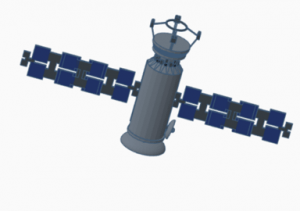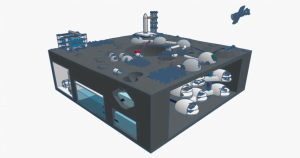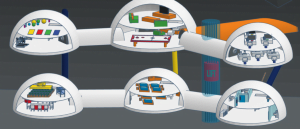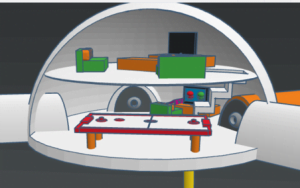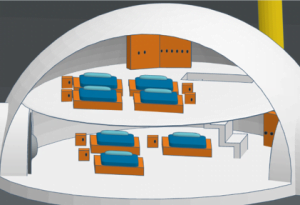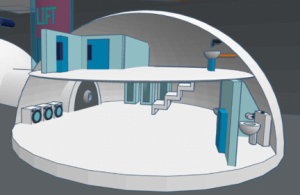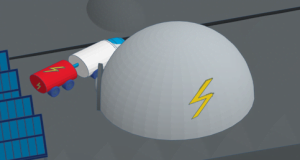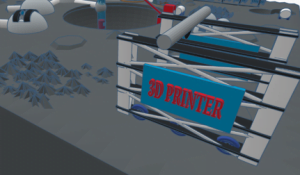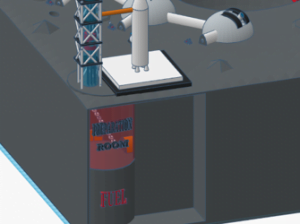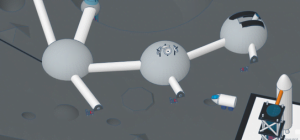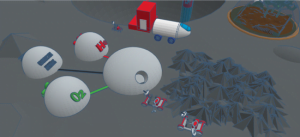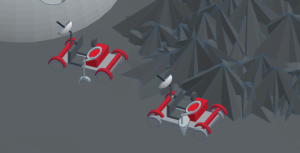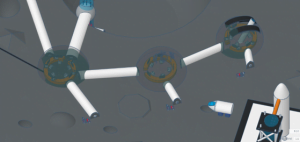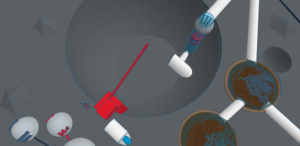Moon Camp Explorers Gallery 2020-2021
In Moon Camp Explorers each team’s mission is to 3D design a complete Moon Camp using Tinkercad. They also have to explain how they will use local resources, protect astronauts from the dangerous of space and describe the living and working facilities.
Team: G.O.K.V.A.X EXPLORERS
Ellinogermaniki Agogi Athens Greece 14
External link for 3d
|
Project description
The name of our moon base is “EKATI” named after the goddess of the Greek Mythology that is associated with the Moon. She was adored for her magical capabilities to keep away evil from the everyday life and she was the children’s protector. Therefore, we named our base after her, expecting that she will protect us from the evil and take care of our “newborn” base, the first of its kind. Our base will accommodate seven astronauts. Our goal is to build a base as sufficient as possible, using local resources and materials (i.e. regolith, ice, sunlight) as much as possible. We aim to establish a research base for longer periods in order to explore the lunar surface and carry out experiments on self-sufficient human life on the moon. Our long-term goal is to establish a base that will serve for exploration to Mars and when it is sufficiently equipped to serve as a tourist destination. Finally, the technology developed for our project could also be applicable on Earth in order to improve our quality of life. Concerning power production, we will produce power in many different ways for three reasons: There is a great need for power because there are long periods (almost 2 weeks) with no sunlight. |
|||
|
Where do you want to build your Moon Camp?
In a cave located close to the volcanic domes, Marius Hills, near the equator. Why did you choose this location?
Our camp will be located in a cave that is close to the volcanic domes, Marius Hills. It is a lava tube and contains ice (opening 50m wide and 50m deep and chasm 50km long and 100m wide). It is the best candidate site because of the stable thermal conditions and potential to protect people and instruments from micrometeorites, extreme temperatures, cosmic ray radiation and radiation from the sun’s ultraviolet rays. Since it is located close to the equator, landing and launching is easier, and the communication with Earth more efficient. Lava tubes are along the boundaries between lunar mares and highland regions, so there are elevated regions for better communication, basaltic plains for landing and regolith harvesting. How do you plan to build your Moon Camp? Which materials would you use?
A 3D printer will be brought from Earth to build a protective layer for the facilities on the surface (communication and control room, laboratories, observatory, power, helium, oxygen and construction material storage, waste management and regolith processing buildings), by using lunar regolith after we have extracted almost all oxygen. The rest of the living and working facilities (bedrooms, toilets, kitchen, entertainment room, gym and meditation room, office-laboratory) will be built underground, in two layers connected with an elevator, by using inflated parts brought from Earth. Air-lock doors will be used. An elevator and a crane facilitate the entrance of heavy objects into the cave. The greenhouses on the surface will be protected by a special glass. Explain how your Moon Camp will provide the astronauts with:
|
|||
|
Water
|
Food
|
Electricity
|
Air
|
|
-We will get water by melting the ice that is already available in the cave. |
-We will plant seeds and nano trees brought from Earth, to cultivate vegetables (i.e. potatoes, tomatoes, Chinese cabbage, a |
-Helium – 3 extracted from lunar regolith can provide us with large quantities of energy and rocket fuel. |
-Oxygen will be extracted in two ways, from water with the method of electrolysis and from the regolith (lunar soil). Then it |
|
Describe a day on the Moon for one of your Moon Camp astronauts
Our camp follows Central European Time (CET). Astronauts wake up early in the morning, at 6.30 a.m. and they spend an hour on their personal hygiene and preparing and having breakfast. Until 8.30 a.m., they discuss the day plan and then they start working on the project assigned to each one of them according to their specialization (i.e. engineers, biologists, geneticists, botanists, mineralogists). Their work can take place either outdoor, in the camp or elsewhere on the moon surface, or indoor, in the aboveground laboratories, the observatory, the greenhouses, the power storage, the waste management (recycling) building or in the underground laboratories and office. Around 1 p.m., they have an hour break for lunch. After that, they continue working until 6 p.m. Then, they have time to exercise and meditate (yoga, Pilates, bicycle, weights, treadmill). Exercising is very important because lack of gravity weakens the muscles and may cause serious problems. Later they have dinner and after that, they have some personal time for entertainment (movies, video games, Air-Hokey, e-books, music), to communicate among themselves, as well as with their families, their friends and their psychologist. Sessions with the psychologist are necessary at least twice a week to maintain mental health as life there is very hard and demanding. At around 9 p.m. they spend some time for their personal hygiene and prepare to sleep. On Saturdays, the astronauts spend their time on maintaining facilities and vehicles, cleaning and tiding. On Sundays, they have free time to relax, amuse themselves and get updated on the news. |
|||


